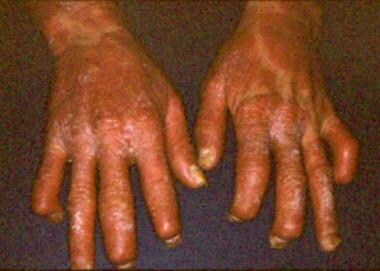Ritchlin CT, Colbert RA, Gladman DD. Psoriatic Arthritis. N Engl J Med. 2017 Mar 9. 376 (10):957-970. [QxMD MEDLINE Link].
Alinaghi F, Calov M, Kristensen LE, Gladman DD, Coates LC, Jullien D, et al. Prevalence of psoriatic arthritis in patients with psoriasis: A systematic review and meta-analysis of observational and clinical studies. J Am Acad Dermatol. 2018 Jun 18. [QxMD MEDLINE Link].
Taylor W, Gladman D, Helliwell P, Marchesoni A, Mease P, Mielants H. Classification criteria for psoriatic arthritis: development of new criteria from a large international study. Arthritis Rheum. 2006 Aug. 54(8):2665-73. [QxMD MEDLINE Link].
FitzGerald O, Ogdie A, Chandran V, Coates LC, Kavanaugh A, Tillett W, et al. Psoriatic arthritis. Nat Rev Dis Primers. 2021 Aug 12. 7 (1):59. [QxMD MEDLINE Link].
Saad AA, Symmons DP, Noyce PR, Ashcroft DM. Risks and benefits of tumor necrosis factor-alpha inhibitors in the management of psoriatic arthritis: systematic review and metaanalysis of randomized controlled trials. J Rheumatol. 2008 May. 35(5):883-90. [QxMD MEDLINE Link].
Merola JF, Tian H, Patil D, Richardson C, Scott A, Chen YH, et al. Incidence and prevalence of psoriatic arthritis in patients with psoriasis stratified by psoriasis disease severity: Retrospective analysis of an electronic health records database in the United States. J Am Acad Dermatol. 2022 Apr. 86 (4):748-757. [QxMD MEDLINE Link]. [Full Text].
Reich K, Kruger K, Mossner R, Augustin M. Epidemiology and clinical pattern of psoriatic arthritis in Germany: a prospective interdisciplinary epidemiological study of 1511 patients with plaque-type psoriasis. Br J Dermatol. 2009 May. 160(5):1040-7. [QxMD MEDLINE Link].
Kavanaugh A, McInnes I, Mease P, Krueger GG, Gladman D, Gomez-Reino J, et al. Golimumab, a new human tumor necrosis factor alpha antibody, administered every four weeks as a subcutaneous injection in psoriatic arthritis: Twenty-four-week efficacy and safety results of a randomized, placebo-controlled study. Arthritis Rheum. 2009 Apr. 60(4):976-86. [QxMD MEDLINE Link].
Guttman-Yassky E, Krueger JG. Psoriasis: evolution of pathogenic concepts and new therapies through phases of translational research. Br J Dermatol. 2007 Dec. 157(6):1103-15. [QxMD MEDLINE Link].
Fitzgerald O, Winchester R. Psoriatic arthritis: from pathogenesis to therapy. Arthritis Res Ther. 2009. 11(1):214. [QxMD MEDLINE Link]. [Full Text].
Chamot AM, Benhamou CL, Kahn MF, Beraneck L, Kaplan G, Prost A. [Acne-pustulosis-hyperostosis-osteitis syndrome. Results of a national survey. 85 cases]. Rev Rhum Mal Osteoartic. 1987 Mar. 54(3):187-96. [QxMD MEDLINE Link].
Gmyrek R, Grossman ME, Rudin D, Scher R. SAPHO syndrome: report of three cases and review of the literature. Cutis. 1999 Oct. 64(4):253-8. [QxMD MEDLINE Link].
Häfner R, Michels H. Psoriatic arthritis in children. Curr Opin Rheumatol. 1996 Sep. 8 (5):467-72. [QxMD MEDLINE Link].
Fiocco U, Cozzi L, Chieco-Bianchi F, Rigon C, Vezzu M, Favero E, et al. Vascular changes in psoriatic knee joint synovitis. J Rheumatol. 2001 Nov. 28(11):2480-6. [QxMD MEDLINE Link].
Nograles KE, Brasington RD, Bowcock AM. New insights into the pathogenesis and genetics of psoriatic arthritis. Nat Clin Pract Rheumatol. 2009 Feb. 5(2):83-91. [QxMD MEDLINE Link]. [Full Text].
Duffin KC, Chandran V, Gladman DD, Krueger GG, Elder JT, Rahman P. Genetics of psoriasis and psoriatic arthritis: update and future direction. J Rheumatol. 2008 Jul. 35(7):1449-53. [QxMD MEDLINE Link]. [Full Text].
Chandran V, Schentag CT, Brockbank JE, Pellett FJ, Shanmugarajah S, Toloza SM, et al. Familial aggregation of psoriatic arthritis. Ann Rheum Dis. 2009 May. 68(5):664-7. [QxMD MEDLINE Link].
Liu Y, Helms C, Liao W, Zaba LC, Duan S, Gardner J, et al. A genome-wide association study of psoriasis and psoriatic arthritis identifies new disease loci. PLoS Genet. 2008 Mar 28. 4(3):e1000041. [QxMD MEDLINE Link]. [Full Text].
Nair RP, Duffin KC, Helms C, Ding J, Stuart PE, Goldgar D, et al. Genome-wide scan reveals association of psoriasis with IL-23 and NF-kappaB pathways. Nat Genet. 2009 Feb. 41(2):199-204. [QxMD MEDLINE Link]. [Full Text].
Huffmeier U, Uebe S, Ekici AB, Bowes J, Giardina E, Korendowych E, et al. Common variants at TRAF3IP2 are associated with susceptibility to psoriatic arthritis and psoriasis. Nat Genet. 2010 Nov. 42(11):996-9. [QxMD MEDLINE Link]. [Full Text].
Sun LD, Cheng H, Wang ZX, Zhang AP, Wang PG, Xu JH, et al. Association analyses identify six new psoriasis susceptibility loci in the Chinese population. Nat Genet. 2010 Nov. 42(11):1005-9. [QxMD MEDLINE Link]. [Full Text].
Ellinghaus E, Ellinghaus D, Stuart PE, Nair RP, Debrus S, Raelson JV, et al. Genome-wide association study identifies a psoriasis susceptibility locus at TRAF3IP2. Nat Genet. 2010 Nov. 42(11):991-5. [QxMD MEDLINE Link]. [Full Text].
Cargill M, Schrodi SJ, Chang M, Garcia VE, Brandon R, Callis KP, et al. A large-scale genetic association study confirms IL12B and leads to the identification of IL23R as psoriasis-risk genes. Am J Hum Genet. 2007 Feb. 80(2):273-90. [QxMD MEDLINE Link]. [Full Text].
Huffmeier U, Lascorz J, Bohm B, Lohmann J, Wendler J, Mossner R, et al. Genetic variants of the IL-23R pathway: association with psoriatic arthritis and psoriasis vulgaris, but no specific risk factor for arthritis. J Invest Dermatol. 2009 Feb. 129(2):355-8. [QxMD MEDLINE Link].
Al-Heresh AM, Proctor J, Jones SM, Dixey J, Cox B, Welsh K, et al. Tumour necrosis factor-alpha polymorphism and the HLA-Cw*0602 allele in psoriatic arthritis. Rheumatology (Oxford). 2002 May. 41(5):525-30. [QxMD MEDLINE Link].
Choy E. T cells in psoriatic arthritis. Curr Rheumatol Rep. 2007 Dec. 9(6):437-41. [QxMD MEDLINE Link].
Ho PY, Barton A, Worthington J, Plant D, Griffiths CE, Young HS, et al. Investigating the role of the HLA-Cw*06 and HLA-DRB1 genes in susceptibility to psoriatic arthritis: comparison with psoriasis and undifferentiated inflammatory arthritis. Ann Rheum Dis. 2008 May. 67(5):677-82. [QxMD MEDLINE Link]. [Full Text].
Nickoloff BJ, Nestle FO. Recent insights into the immunopathogenesis of psoriasis provide new therapeutic opportunities. J Clin Invest. 2004 Jun. 113(12):1664-75. [QxMD MEDLINE Link]. [Full Text].
Nair RP, Stuart PE, Nistor I, Hiremagalore R, Chia NV, Jenisch S, et al. Sequence and haplotype analysis supports HLA-C as the psoriasis susceptibility 1 gene. Am J Hum Genet. 2006 May. 78(5):827-51. [QxMD MEDLINE Link]. [Full Text].
Eder L, Pellett F, Chandran V, Shanmugarajah S, Gladman DD. HLA- B*27 and Cw*06 are risk alleles for psoriatic arthritis among psoriasis patients (abstract). Arthritis Rheum. 2010. 62(suppl 10):1974.
Kimball AB, Gordon KB, Langley RG, Menter A, Chartash EK, Valdes J. Safety and efficacy of ABT-874, a fully human interleukin 12/23 monoclonal antibody, in the treatment of moderate to severe chronic plaque psoriasis: results of a randomized, placebo-controlled, phase 2 trial. Arch Dermatol. 2008 Feb. 144(2):200-7. [QxMD MEDLINE Link].
Rahman P, Siannis F, Butt C, Farewell V, Peddle L, Pellett F, et al. TNFalpha polymorphisms and risk of psoriatic arthritis. Ann Rheum Dis. 2006 Jul. 65(7):919-23. [QxMD MEDLINE Link]. [Full Text].
Rahman P, Roslin NM, Pellett FJ, Lemire M, Greenwood CM, Beyene J, et al. High resolution mapping in the major histocompatibility complex region identifies multiple independent novel loci for psoriatic arthritis. Ann Rheum Dis. 2011 Apr. 70(4):690-4. [QxMD MEDLINE Link].
Pollock R, Chandran V, Barrett J, Eder L, Pellett F, Yao C, et al. Differential major histocompatibility complex class I chain-related A allele associations with skin and joint manifestations of psoriatic disease. Tissue Antigens. 2011 Jun. 77(6):554-61. [QxMD MEDLINE Link].
Benson JM, Sachs CW, Treacy G, Zhou H, Pendley CE, Brodmerkel CM, et al. Therapeutic targeting of the IL-12/23 pathways: generation and characterization of ustekinumab. Nat Biotechnol. 2011 Jul. 29(7):615-24. [QxMD MEDLINE Link].
Strange A, Capon F, Spencer CC, Knight J, Weale ME, Allen MH, et al. A genome-wide association study identifies new psoriasis susceptibility loci and an interaction between HLA-C and ERAP1. Nat Genet. 2010 Nov. 42(11):985-90. [QxMD MEDLINE Link]. [Full Text].
van Kuijk AW, Tak PP. Synovitis in psoriatic arthritis: immunohistochemistry, comparisons with rheumatoid arthritis, and effects of therapy. Curr Rheumatol Rep. 2011 Aug. 13 (4):353-9. [QxMD MEDLINE Link]. [Full Text].
Coates LC, FitzGerald O, Helliwell PS, Paul C. Psoriasis, psoriatic arthritis, and rheumatoid arthritis: Is all inflammation the same?. Semin Arthritis Rheum. 2016 Dec. 46 (3):291-304. [QxMD MEDLINE Link]. [Full Text].
Kruithof E, Baeten D, De Rycke L, Vandooren B, Foell D, Roth J, et al. Synovial histopathology of psoriatic arthritis, both oligo- and polyarticular, resembles spondyloarthropathy more than it does rheumatoid arthritis. Arthritis Res Ther. 2005. 7 (3):R569-80. [QxMD MEDLINE Link]. [Full Text].
Rahimi H, Ritchlin CT. Altered bone biology in psoriatic arthritis. Curr Rheumatol Rep. 2012 Aug. 14 (4):349-57. [QxMD MEDLINE Link]. [Full Text].
Eder L, Shanmugarajah S, Thavaneswaran A, Chandran V, Rosen CF, Cook RJ, et al. The association between smoking and the development of psoriatic arthritis among psoriasis patients. Ann Rheum Dis. 2012 Feb. 71 (2):219-24. [QxMD MEDLINE Link].
About Psoriatic Arthritis. National Psoriasis Foundation. Available at https://www.psoriasis.org/about-psoriatic-arthritis/. February 16, 2024; Accessed: December 7, 2019.
Gelfand JM, Gladman DD, Mease PJ, Smith N, Margolis DJ, Nijsten T, et al. Epidemiology of psoriatic arthritis in the population of the United States. J Am Acad Dermatol. 2005 Oct. 53 (4):573. [QxMD MEDLINE Link].
Wilson FC, Icen M, Crowson CS, McEvoy MT, Gabriel SE, Kremers HM. Incidence and clinical predictors of psoriatic arthritis in patients with psoriasis: a population-based study. Arthritis Rheum. 2009 Feb 15. 61(2):233-9. [QxMD MEDLINE Link]. [Full Text].
Wilson FC, Icen M, Crowson CS, McEvoy MT, Gabriel SE, Kremers HM. Time trends in epidemiology and characteristics of psoriatic arthritis over 3 decades: a population-based study. J Rheumatol. 2009 Feb. 36(2):361-7. [QxMD MEDLINE Link]. [Full Text].
Scotti L, Franchi M, Marchesoni A, Corrao G. Prevalence and incidence of psoriatic arthritis: A systematic review and meta-analysis. Semin Arthritis Rheum. 2018 Aug. 48 (1):28-34. [QxMD MEDLINE Link].
Henes JC, Ziupa E, Eisfelder M, Adamczyk A, Knaudt B, Jacobs F, et al. High prevalence of psoriatic arthritis in dermatological patients with psoriasis: a cross-sectional study. Rheumatol Int. 2013 Oct 10. [QxMD MEDLINE Link].
Eder L, Haddad A, Rosen CF, Lee KA, Chandran V, Cook R, et al. The incidence and risk factors for psoriatic arthritis in patients with psoriasis - a prospective cohort study. Arthritis Rheumatol. 2015 Nov 10. [QxMD MEDLINE Link]. [Full Text].
Kerr GS, Qaiyumi S, Richards J, Vahabzadeh-Monshie H, Kindred C, Whelton S, et al. Psoriasis and psoriatic arthritis in African-American patients--the need to measure disease burden. Clin Rheumatol. 2015 Oct. 34 (10):1753-9. [QxMD MEDLINE Link].
Eder L, Thavaneswaran A, Chandran V, Gladman DD. Gender difference in disease expression, radiographic damage and disability among patients with psoriatic arthritis. Ann Rheum Dis. 2013 Apr. 72(4):578-82. [QxMD MEDLINE Link].
Zangger P, Gladman DD, Bogoch ER. Musculoskeletal surgery in psoriatic arthritis. J Rheumatol. 1998 Apr. 25 (4):725-9. [QxMD MEDLINE Link].
Buckley C, Cavill C, Taylor G, Kay H, Waldron N, Korendowych E, et al. Mortality in psoriatic arthritis - a single-center study from the UK. J Rheumatol. 2010 Oct. 37(10):2141-4. [QxMD MEDLINE Link].
Husted JA, Thavaneswaran A, Chandran V, Eder L, Rosen CF, Cook RJ, et al. Cardiovascular and other comorbidities in patients with psoriatic arthritis: a comparison with patients with psoriasis. Arthritis Care Res (Hoboken). 2011 Dec. 63(12):1729-35. [QxMD MEDLINE Link].
Labitigan M, Bahce-Altuntas A, Kremer JM, Reed G, Greenberg JD, Jordan N, et al. Higher rates and clustering of abnormal lipids, obesity, and diabetes in psoriatic arthritis compared with rheumatoid arthritis. Arthritis Care Res (Hoboken). 2013 Oct 7. [QxMD MEDLINE Link].
Semb AG, Kvien TK, DeMicco DA, Fayyad R, Wun CC, LaRosa JC, et al. Effect of intensive lipid-lowering therapy on cardiovascular outcome in patients with and those without inflammatory joint disease. Arthritis Rheum. 2012 Sep. 64(9):2836-46. [QxMD MEDLINE Link].
Ursin K, Lydersen S, Skomsvoll JF, Wallenius M. Disease activity of psoriatic arthritis during and after pregnancy: A prospective multicenter study. Arthritis Care Res (Hoboken). 2018 Sep 7. [QxMD MEDLINE Link].
Snoeck Henkemans SVJ, de Jong PHP, Luime JJ, Kok MR, Tchetverikov I, Korswagen LA, et al. Window of opportunity in psoriatic arthritis: the earlier the better?. RMD Open. 2024 Feb 27. 10 (1):[QxMD MEDLINE Link]. [Full Text].
Gottlieb AB, Merola JF. Axial psoriatic arthritis: An update for dermatologists. J Am Acad Dermatol. 2021 Jan. 84 (1):92-101. [QxMD MEDLINE Link]. [Full Text].
Eder L, Polachek A, Rosen CF, Chandran V, Cook R, Gladman DD. The Development of Psoriatic Arthritis in Patients With Psoriasis Is Preceded by a Period of Nonspecific Musculoskeletal Symptoms: A Prospective Cohort Study. Arthritis Rheumatol. 2017 Mar. 69 (3):622-629. [QxMD MEDLINE Link].
Merola JF, Chakravarty SD, Choi O, Chan D, Gottlieb AB. A clinical review of structural damage in psoriatic arthritis for dermatologists: From pathogenesis to ongoing controversies. J Am Acad Dermatol. 2024 Feb. 90 (2):349-357. [QxMD MEDLINE Link]. [Full Text].
Augustin M, Blome C, Costanzo A, Dauden E, Ferrandiz C, Girolomoni G, et al. Nail Assessment in Psoriasis and Psoriatic Arthritis (NAPPA): Development and Validation of a Tool for Assessment of Nail Psoriasis Outcomes. Br J Dermatol. 2013 Oct 11. [QxMD MEDLINE Link].
Sanyal K, Stuart B. Osteopoikilosis: spotted bone disease in a patient with psoriatic arthritis. J Clin Rheumatol. 2010 Aug. 16(5):251. [QxMD MEDLINE Link].
Siannis F, Farewell VT, Cook RJ, Schentag CT, Gladman DD. Clinical and radiological damage in psoriatic arthritis. Ann Rheum Dis. 2006 Apr. 65(4):478-81. [QxMD MEDLINE Link]. [Full Text].
Tillett W, Jadon D, Shaddick G, Robinson G, Sengupta R, Korendowych E, et al. Feasibility, reliability, and sensitivity to change of four radiographic scoring methods in patients with psoriatic arthritis. Arthritis Care Res (Hoboken). 2014 Feb. 66 (2):311-7. [QxMD MEDLINE Link]. [Full Text].
Salaffi F, Carotti M, Di Donato E, Di Carlo M, Luchetti MM, Ceccarelli L, et al. Preliminary validation of the Simplified Psoriatic Arthritis Radiographic Score (SPARS). Skeletal Radiol. 2019 Jul. 48 (7):1033-1041. [QxMD MEDLINE Link].
Zabotti A, Mandl P, Zampogna G, Dejaco C, Iagnocco A. One year in review 2018: ultrasonography in rheumatoid arthritis and psoriatic arthritis. Clin Exp Rheumatol. 2018 Jul-Aug. 36 (4):519-525. [QxMD MEDLINE Link]. [Full Text].
Smerilli G, Di Matteo A, Cipolletta E, Grassi W, Filippucci E. Enthesitis in Psoriatic Arthritis, the Sonographic Perspective. Curr Rheumatol Rep. 2021 Aug 24. 23 (9):75. [QxMD MEDLINE Link]. [Full Text].
Van den Bosch F, Coates L. Clinical management of psoriatic arthritis. Lancet. 2018 Jun 2. 391 (10136):2285-2294. [QxMD MEDLINE Link].
Feldman SR. A quantitative definition of severe psoriasis for use in clinical trials. J Dermatolog Treat. 2004 Jan. 15:27-9. [QxMD MEDLINE Link].
Pariser DM, Bagel J, Gelfand JM, Korman NJ, Ritchlin CT, Strober BE, et al. National Psoriasis Foundation clinical consensus on disease severity. Arch Dermatol. 2007 Feb. 143:239–42. [QxMD MEDLINE Link].
Helliwell PS, Kavanaugh A. Comparison of composite measures of disease activity in psoriatic arthritis using data from an interventional study with golimumab. Arthritis Care Res (Hoboken). 2013 Oct 14. [QxMD MEDLINE Link].
Mulder M, den Broeder A, van Ginneken B, Vriezekolk J, Mahler E, van den Hoogen F, et al. SAT0392 IMPLEMENTING THE PSORIATIC ARTHRITIS DISEASE ACTIVITY SCORE (PASDAS) IN ROUTINE CLINICAL PRACTICE: (IM)POSSIBLE?. Ann Rheum Dis. June 15, 2019. 78 suppl 2:[Full Text].
Chat VS, Ellebrecht CT, Kingston P, et al. Vaccination Recommendations for Adults Receiving Biologics and Oral Therapies for Psoriasis and Psoriatic Arthritis: Delphi Consensus from the Medical Board of the National Psoriasis Foundation. J Am Acad Dermatol. 2024 Feb 6. [QxMD MEDLINE Link].
Scarpa R, Peluso R, Atteno M, Manguso F, Spano A, Iervolino S, et al. The effectiveness of a traditional therapeutical approach in early psoriatic arthritis: results of a pilot randomised 6-month trial with methotrexate. Clin Rheumatol. 2008 Jul. 27(7):823-6. [QxMD MEDLINE Link].
Lindsay K, Fraser AD, Layton A, Goodfield M, Gruss H, Gough A. Liver fibrosis in patients with psoriasis and psoriatic arthritis on long-term, high cumulative dose methotrexate therapy. Rheumatology (Oxford). 2009 May. 48(5):569-72. [QxMD MEDLINE Link].
Boggs W. Methotrexate Side Effects, Intolerance Common in Arthritis Patients. Medscape Medical News. Available at http://www.medscape.com/viewarticle/818646. Accessed: January 14, 2014.
Bulatovic Calasan M, van den Bosch OF, Creemers MC, Custers M, Heurkens AH, van Woerkom JM, et al. Prevalence of methotrexate intolerance in rheumatoid arthritis and psoriatic arthritis. Arthritis Res Ther. 2013 Dec 18. 15(6):R217. [QxMD MEDLINE Link].
Mease PJ, Gladman DD, Ritchlin CT, Ruderman EM, Steinfeld SD, Choy EH, et al. Adalimumab for the treatment of patients with moderately to severely active psoriatic arthritis: results of a double-blind, randomized, placebo-controlled trial. Arthritis Rheum. 2005 Oct. 52(10):3279-89. [QxMD MEDLINE Link].
Yang K, Oak ASW, Elewski BE. Use of IL-23 Inhibitors for the Treatment of Plaque Psoriasis and Psoriatic Arthritis: A Comprehensive Review. Am J Clin Dermatol. 2021 Mar. 22 (2):173-192. [QxMD MEDLINE Link]. [Full Text].
Mease PJ, McInnes IB, Kirkham B, Kavanaugh A, Rahman P, van der Heijde D, et al. Secukinumab Inhibition of Interleukin-17A in Patients with Psoriatic Arthritis. N Engl J Med. 2015 Oct. 373 (14):1329-39. [QxMD MEDLINE Link].
McInnes IB, Mease PJ, Kirkham B, Kavanaugh A, Ritchlin CT, Rahman P, et al. Secukinumab, a human anti-interleukin-17A monoclonal antibody, in patients with psoriatic arthritis (FUTURE 2): a randomised, double-blind, placebo-controlled, phase 3 trial. Lancet. 2015 Sep 19. 386 (9999):1137-46. [QxMD MEDLINE Link].
Brooks M. FDA approves certolizumab for psoriatic arthritis. Medscape Medical News. September 30, 2013. [Full Text].
Walsh JA, Gottlieb AB, Hoepken B, Nurminen T, Mease PJ. Efficacy of certolizumab pegol with and without concomitant use of disease-modifying anti-rheumatic drugs over 4 years in psoriatic arthritis patients: results from the RAPID-PsA randomized controlled trial. Clin Rheumatol. 2018 Sep 6. [QxMD MEDLINE Link].
Kavanaugh A, Husni ME, Harrison DD, Kim L, Lo KH, Leu JH, et al. Safety and efficacy of intravenous golimumab in patients with active psoriatic arthritis: Results through week 24 of the GO-VIBRANT study. Arthritis Rheumatol. 2017 Aug 13. [QxMD MEDLINE Link]. [Full Text].
Brooks M. Ustekinumab approved for psoriatic arthritis in US, Europe. Medscape Medical News [serial online]. September 23, 2013. Medscape. Available at http://www.medscape.com/viewarticle/811496. Accessed: October 25, 2013.
McInnes IB, Kavanaugh A, Gottlieb AB, Puig L, Rahman P, Ritchlin C, et al. Efficacy and safety of ustekinumab in patients with active psoriatic arthritis: 1 year results of the phase 3, multicentre, double-blind, placebo-controlled PSUMMIT 1 trial. Lancet. 2013 Aug 31. 382(9894):780-9. [QxMD MEDLINE Link].
Tremfya (guselkumab) [package insert]. Horsham, PA: Janssen Biotech, Inc. July 2020. Available at [Full Text].
Kristensen LE, Keiserman M, Papp K, McCasland L, White D, Lu W, et al. Efficacy and safety of risankizumab for active psoriatic arthritis: 24-week results from the randomised, double-blind, phase 3 KEEPsAKE 1 trial. Ann Rheum Dis. 2022 Feb. 81 (2):225-231. [QxMD MEDLINE Link]. [Full Text].
Östör A, Van den Bosch F, Papp K, Asnal C, Blanco R, Aelion J, et al. Efficacy and safety of risankizumab for active psoriatic arthritis: 24-week results from the randomised, double-blind, phase 3 KEEPsAKE 2 trial. Ann Rheum Dis. 2021 Nov 23. [QxMD MEDLINE Link]. [Full Text].
Baraliakos X, Gossec L, Pournara E, Jeka S, Mera-Varela A, D'Angelo S, et al. Secukinumab in patients with psoriatic arthritis and axial manifestations: results from the double-blind, randomised, phase 3 MAXIMISE trial. Ann Rheum Dis. 2021 May. 80 (5):582-590. [QxMD MEDLINE Link]. [Full Text].
Mease PJ, Gottlieb AB, van der Heijde D, FitzGerald O, Johnsen A, Nys M, et al. Efficacy and safety of abatacept, a T-cell modulator, in a randomised, double-blind, placebo-controlled, phase III study in psoriatic arthritis. Ann Rheum Dis. 2017 May 4. [QxMD MEDLINE Link]. [Full Text].
Mease PJ, van der Heijde D, Ritchlin CT, Okada M, Cuchacovich RS, Shuler CL, et al. Ixekizumab, an interleukin-17A specific monoclonal antibody, for the treatment of biologic-naive patients with active psoriatic arthritis: results from the 24-week randomised, double-blind, placebo-controlled and active (adalimumab)-controlled period of the phase III trial SPIRIT-P1. Ann Rheum Dis. 2017 Jan. 76 (1):79-87. [QxMD MEDLINE Link]. [Full Text].
Nash P, Kirkham B, Okada M, Rahman P, Combe B, Burmester GR, et al. Ixekizumab for the treatment of patients with active psoriatic arthritis and an inadequate response to tumour necrosis factor inhibitors: results from the 24-week randomised, double-blind, placebo-controlled period of the SPIRIT-P2 phase 3 trial. Lancet. 2017 Jun 10. 389 (10086):2317-2327. [QxMD MEDLINE Link].
Mease P, Hall S, FitzGerald O, van der Heijde D, Merola JF, Avila-Zapata F, et al. Tofacitinib or Adalimumab versus Placebo for Psoriatic Arthritis. N Engl J Med. 2017 Oct 19. 377 (16):1537-1550. [QxMD MEDLINE Link]. [Full Text].
Gladman D, Rigby W, Azevedo VF, Behrens F, Blanco R, Kaszuba A, et al. Tofacitinib for Psoriatic Arthritis in Patients with an Inadequate Response to TNF Inhibitors. N Engl J Med. 2017 Oct 19. 377 (16):1525-1536. [QxMD MEDLINE Link]. [Full Text].
McInnes IB, Anderson JK, Magrey M, Merola JF, Liu Y, Kishimoto M, et al. Trial of Upadacitinib and Adalimumab for Psoriatic Arthritis. N Engl J Med. 2021 Apr 1. 384 (13):1227-1239. [QxMD MEDLINE Link].
Mease PJ, Lertratanakul A, Anderson JK, Papp K, Van den Bosch F, Tsuji S, et al. Upadacitinib for psoriatic arthritis refractory to biologics: SELECT-PsA 2. Ann Rheum Dis. 2021 Mar. 80 (3):312-320. [QxMD MEDLINE Link]. [Full Text].
Mease P, Setty A, Papp K, Van den Bosch F, Tsuji S, Keiserman M, et al. Upadacitinib in patients with psoriatic arthritis and inadequate response to biologics: 3-year results from the open-label extension of the randomised controlled phase 3 SELECT-PsA 2 study. Clin Exp Rheumatol. 2023 Nov. 41 (11):2286-2297. [QxMD MEDLINE Link]. [Full Text].
Kavanaugh A, Mease PJ, Gomez-Reino JJ, Adebajo AO, Wollenhaupt J, Gladman DD, et al. Treatment of psoriatic arthritis in a phase 3 randomised, placebo-controlled trial with apremilast, an oral phosphodiesterase 4 inhibitor. Ann Rheum Dis. 2014 Mar 4. [QxMD MEDLINE Link].
Schett G, Wollenhaupt J, Papp K, Joos R, Rodrigues JF, Vessey AR, et al. Oral apremilast in the treatment of active psoriatic arthritis: results of a multicenter, randomized, double-blind, placebo-controlled study. Arthritis Rheum. 2012 Oct. 64(10):3156-67. [QxMD MEDLINE Link].
Brooks M. FDA Clears Apremilast (Otezla) for Psoriatic Arthritis. Medscape Medical News. Available at http://www.medscape.com/viewarticle/822396. Accessed: March 24, 2014.
Otezla (apremilast) prescribing information [package insert]. Summit, NJ.: Celgene Corp. 2014. Available at [Full Text].
Tanaka Y, Shaw S. Bimekizumab for the treatment of psoriatic arthritis. Expert Rev Clin Immunol. 2024 Feb. 20 (2):155-168. [QxMD MEDLINE Link].
Mease PJ, Reich K. Alefacept with methotrexate for treatment of psoriatic arthritis: open-label extension of a randomized, double-blind, placebo-controlled study. J Am Acad Dermatol. 2009 Mar. 60(3):402-11. [QxMD MEDLINE Link].
Soriano A, Pipitone N, Salvarani C. Cyclosporine in psoriatic arthropathy. Clin Exp Rheumatol. 2015 Sep-Oct. 33 (5 Suppl 93):S101-3. [QxMD MEDLINE Link].
[Guideline] Coates LC, et al; GRAPPA Treatment Recommendations domain subcommittees. Group for Research and Assessment of Psoriasis and Psoriatic Arthritis (GRAPPA): updated treatment recommendations for psoriatic arthritis 2021. Nat Rev Rheumatol. 2022 Aug. 18 (8):465-479. [QxMD MEDLINE Link]. [Full Text].
Hsieh TS, Tsai TF. Combination of methotrexate with oral disease-modifying antirheumatic drugs in psoriatic arthritis: a systematic review. Immunotherapy. 2024 Feb. 16 (2):115-130. [QxMD MEDLINE Link].
Ford AR, Siegel M, Bagel J, Cordoro KM, Garg A, Gottlieb A, et al. Dietary Recommendations for Adults With Psoriasis or Psoriatic Arthritis From the Medical Board of the National Psoriasis Foundation: A Systematic Review. JAMA Dermatol. 2018 Aug 1. 154 (8):934-950. [QxMD MEDLINE Link].
Sorbara S, Cozzani E, Rebora A, Parodi A. Hydroxychloroquine in psoriasis: is it really harmful?. Acta Derm Venereol. 2006. 86 (5):450-1. [QxMD MEDLINE Link]. [Full Text].
[Guideline] Singh JA, Guyatt G, Ogdie A, Gladman DD, Deal C, et al. Special Article: 2018 American College of Rheumatology/National Psoriasis Foundation Guideline for the Treatment of Psoriatic Arthritis. Arthritis Rheumatol. 2019 Jan. 71 (1):5-32. [QxMD MEDLINE Link]. [Full Text].
Coates LC, Fransen J, Helliwell PS. Defining minimal disease activity in psoriatic arthritis: a proposed objective target for treatment. Ann Rheum Dis. 2010 Jan. 69:48–53. [QxMD MEDLINE Link].
Taylor G, McNeill A, Girling A, Farley A, Lindson-Hawley N, Aveyard P. Change in mental health after smoking cessation: systematic review and meta-analysis. BMJ. 2014 feb. 348:g1158. [QxMD MEDLINE Link].
Critchley JA, Capewell S. Mortality risk reduction associated with smoking cessation in patients with coronary heart disease: a systematic review. JAMA. 2003 Jul. 290:86–97. [QxMD MEDLINE Link].
Kocijan R, Englbrecht M, Haschka J, Simon D, Kleyer A, Finzel S, et al. Quantitative and Qualitative Changes of Bone in Psoriasis and Psoriatic Arthritis Patients. J Bone Miner Res. 2015 Oct. 30 (10):1775-83. [QxMD MEDLINE Link]. [Full Text].
Simon D, Kleyer A, Bayat S, Tascilar K, Kampylafka E, Meinderink T, et al. Effect of disease-modifying anti-rheumatic drugs on bone structure and strength in psoriatic arthritis patients. Arthritis Res Ther. 2019 Jul 3. 21 (1):162. [QxMD MEDLINE Link]. [Full Text].
Pakchotanon R, Ye Y, Cook RJ, Chandran V, Gladman DD. Liver Abnormalities in Patients with Psoriatic Arthritis. J Rheumatol. 2019 Oct 15. [QxMD MEDLINE Link]. [Full Text].
[Guideline] Gossec L, Baraliakos X, Kerschbaumer A, et al. EULAR recommendations for the management of psoriatic arthritis with pharmacological therapies: 2019 update. Ann Rheum Dis. 2020 Jun. 79 (6):700-712. [QxMD MEDLINE Link]. [Full Text].
[Guideline] Tucker L, Allen A, Chandler D, Ciurtin C, Dick A, Foulkes A, et al. The 2022 British Society for Rheumatology guideline for the treatment of psoriatic arthritis with biologic and targeted synthetic DMARDs. Rheumatology (Oxford). 2022 Aug 30. 61 (9):e255-e266. [QxMD MEDLINE Link]. [Full Text].
[Guideline] Furer V, Rondaan C, Heijstek MW, et al. 2019 update of EULAR recommendations for vaccination in adult patients with autoimmune inflammatory rheumatic diseases. Ann Rheum Dis. 2019 Aug. 1-14.
[Guideline] Agca R, Heslinga SC, Rollefstad S, et al. EULAR recommendations for cardiovascular disease risk management in patients with rheumatoid arthritis and other forms of inflammatory joint disorders: 2015/2016 update. Annals of the Rheumatic Diseases. 2017. 76:17-28.
[Guideline] Mandl P, NavarroCompán V, Terslev L, et al. EULAR recommendations for the use of imaging in the diagnosis and management of spondyloarthritis in clinical practice. Ann Rheum Dis. 2015 April 2. 74:1327–1339.
Singh S, Armstrong AW. Oral small molecules for psoriasis. Semin Cutan Med Surg. 2018 Sep. 37(3):163-166. [QxMD MEDLINE Link].
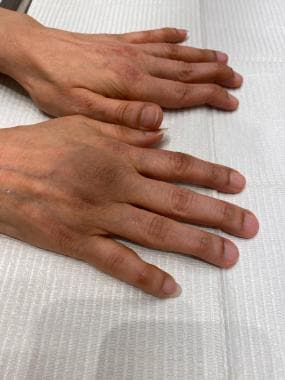 Patient with psoriatic arthritis involving the joints and skin displays features of arthritis mutilans with distal interphalangeal joint destruction causing a deformity and compromise to function.
Patient with psoriatic arthritis involving the joints and skin displays features of arthritis mutilans with distal interphalangeal joint destruction causing a deformity and compromise to function.
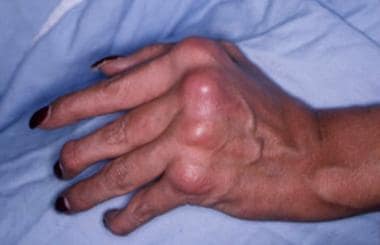 Swelling and deformity of the metacarpophalangeal and distal interphalangeal joints in a patient with psoriatic arthritis.
Swelling and deformity of the metacarpophalangeal and distal interphalangeal joints in a patient with psoriatic arthritis.
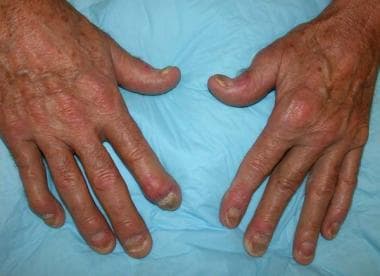 Psoriatic arthritis showing nail changes, distal interphalangeal joint swelling, and sausage digits.
Psoriatic arthritis showing nail changes, distal interphalangeal joint swelling, and sausage digits.
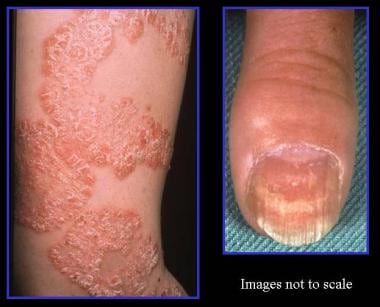 Left, typical appearance of psoriasis, with silvery scaling on a sharply marginated and reddened area of skin overlying the shin. Right, thimblelike pitting of the nail plate in a 56-year-old woman who had suffered from psoriasis for the previous 23 years. Nail pitting, transverse depressions, and subungual hyperkeratosis often occur in association with psoriatic disease of the distal interphalangeal joint. Courtesy of Ali Nawaz Khan, MBBS.
Left, typical appearance of psoriasis, with silvery scaling on a sharply marginated and reddened area of skin overlying the shin. Right, thimblelike pitting of the nail plate in a 56-year-old woman who had suffered from psoriasis for the previous 23 years. Nail pitting, transverse depressions, and subungual hyperkeratosis often occur in association with psoriatic disease of the distal interphalangeal joint. Courtesy of Ali Nawaz Khan, MBBS.

